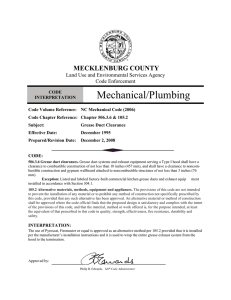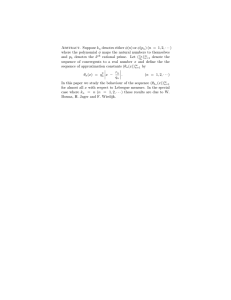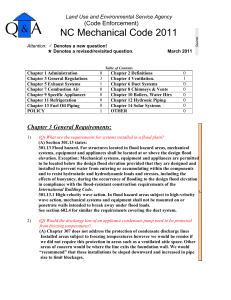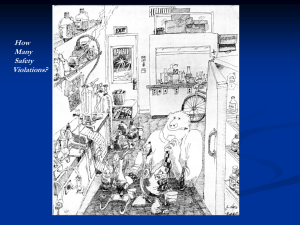Land Use and Environmental Service Agency (Code Enforcement)
advertisement
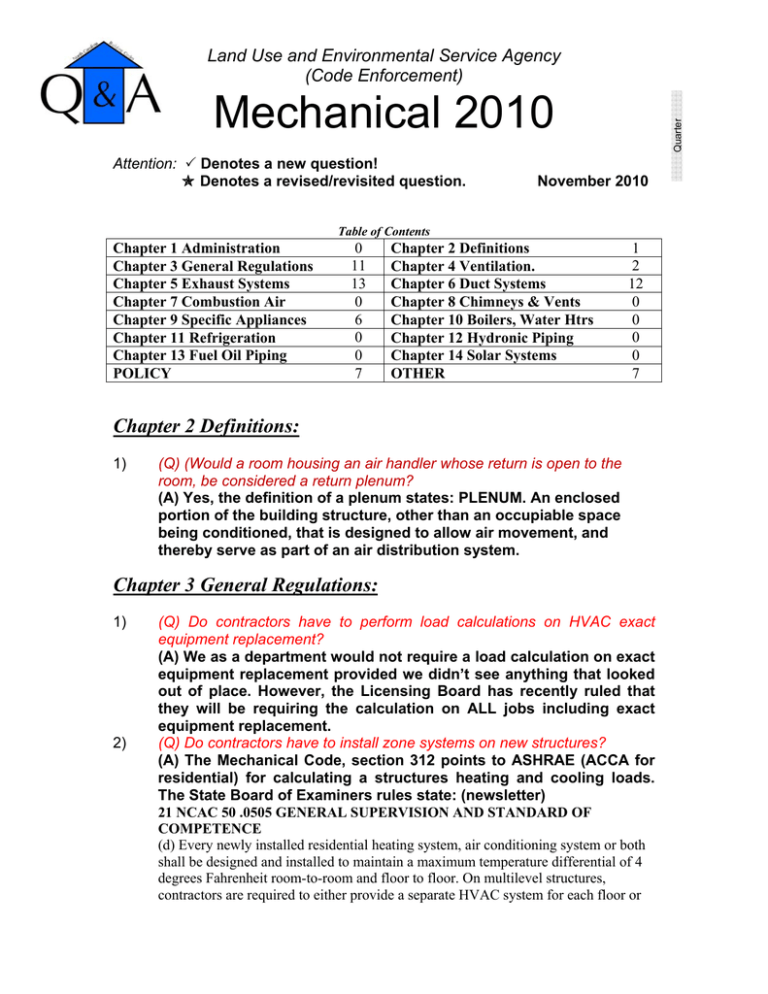
Land Use and Environmental Service Agency (Code Enforcement) Attention: 3 Denotes a new question! z Denotes a revised/revisited question. Quarter Mechanical 2010 November 2010 Table of Contents Chapter 1 Administration Chapter 3 General Regulations Chapter 5 Exhaust Systems Chapter 7 Combustion Air Chapter 9 Specific Appliances Chapter 11 Refrigeration Chapter 13 Fuel Oil Piping POLICY 0 11 13 0 6 0 0 7 Chapter 2 Definitions Chapter 4 Ventilation. Chapter 6 Duct Systems Chapter 8 Chimneys & Vents Chapter 10 Boilers, Water Htrs Chapter 12 Hydronic Piping Chapter 14 Solar Systems OTHER 1 2 12 0 0 0 0 7 Chapter 2 Definitions: 1) (Q) (Would a room housing an air handler whose return is open to the room, be considered a return plenum? (A) Yes, the definition of a plenum states: PLENUM. An enclosed portion of the building structure, other than an occupiable space being conditioned, that is designed to allow air movement, and thereby serve as part of an air distribution system. Chapter 3 General Regulations: 1) 2) (Q) Do contractors have to perform load calculations on HVAC exact equipment replacement? (A) We as a department would not require a load calculation on exact equipment replacement provided we didn’t see anything that looked out of place. However, the Licensing Board has recently ruled that they will be requiring the calculation on ALL jobs including exact equipment replacement. (Q) Do contractors have to install zone systems on new structures? (A) The Mechanical Code, section 312 points to ASHRAE (ACCA for residential) for calculating a structures heating and cooling loads. The State Board of Examiners rules state: (newsletter) 21 NCAC 50 .0505 GENERAL SUPERVISION AND STANDARD OF COMPETENCE (d) Every newly installed residential heating system, air conditioning system or both shall be designed and installed to maintain a maximum temperature differential of 4 degrees Fahrenheit room-to-room and floor to floor. On multilevel structures, contractors are required to either provide a separate HVAC system for each floor or Mechanical 2010 Attention: 3 Denotes a new question! z Denotes a revised/revisited question. November 2010 to install automatically controlled zoning equipment for each level with individual thermostats on each level to control the temperature for that level. The seasonal adjustment needed to maintain the 4 degree Fahrenheit room-to-room and floor-tofloor maximum temperature differential shall not be accomplished through the use of manual dampers. (e) All licensed HVAC contractors are required to perform a thorough room-by-room load calculation for all new residential structures prior to installing heating systems, air conditioning systems, or both which calculations shall be specific to the location and orientation where the HVAC system or equipment is to be installed. A written record of the system and equipment sizing information shall be provided to the owner 3) 4) 5) 6) or general contractor upon request and a copy shall be maintained in the job file of the licensee for a minimum of six (6) years. (f) When either a furnace, condenser, or air handler in an existing residential heating or air conditioning system is replaced, the licensed HVAC contractor is required to perform a minimum of a whole house block load calculation. When a furnace, condenser or air handler in a residential heating or air conditioning system is replaced, it is the responsibility of the licensee to ensure that all systems and equipment are properly sized. The licensee may utilize industry standards, reference materials, evaluation of the structure, and load calculations. A written record of the system and equipment sizing information shall be provided to the homeowner, owner or general contractor upon request and a copy shall be maintained in the job file of the licensee for a minimum of six (6) years. If a load calculation was not performed or if a load calculation was performed and it is later determined by the Board that the unit installed was undersized or oversized, the installation will be considered as evidence of incompetence. (Q) Do the installation of zone systems require an electrical permit? (A) The installation of low and line voltage wiring and components typically found in HVAC systems are required to be permitted by an electrical contractor and inspected. (Q) Where does the zone damper motor have to be placed? (A) Wherever the manufacturer requires. It still must be accessible. (Q) May a single hvac system supply conditioned air to more than one tenant space? (A) Yes provided that the system is zoned such that each space may controlled from within the tenant space or the spaces are controlled by a energy management system by the building owner. (Q) Does a products listing mark have to appear on the product or can the installer provide a letter? (A) The listing mark must be on the product. Quarter Land Use and Environmental Service Agency (Code Enforcement) Mechanical 2010 Attention: 3 Denotes a new question! z Denotes a revised/revisited question. November 2010 7) (Q) How would you access an appliance installed on a mansard roof where there was inadequate room to place the equipment below the roof? (A) Section 306.5 would require a platform not less than 30” with rails (guards) not less than 42” high. 8) (Q) What is required when a room addition covers an existing home’s crawl space opening? (A) You may not create a violation by the installation of new work. The requirements of section 306.4 of the NCMC.NCFG would have to be met. (Q) How does a designer take advantage of the R3 exemption provided in 306.5 of the NCMC and/or NCFG? (A) The design shall meet all of the aspects and limitations found in the R3 definition found in the NCBC. (Q) How much clearance is required for a unit heater installed in a residential garage? (A) Section 304.6 requires 6’ clearance unless properly protected. 9) 10) Quarter Land Use and Environmental Service Agency (Code Enforcement) Mechanical 2010 November 2010 11)9 (Q) May instantaneous water heater flu’s condensate discharge to the primary condensate drain? (A) Yes, per manufacturer’s instructions. (307.1) Chapter 4 Ventilation: 1) 2) (Q) May you use CO2 detectors to reduce the ventilation air requirements found in Chapter 4? (A) The rates established in table 403.3 shall be provided unless statistical data supports alternate anticipated occupant density. However, the use of CO2 detectors, placed 5 to 6 feet above the finish floor in the return air path may be used to operate a variable speed system. The designer shall submit his/her proposal for consideration. The Code Official will determine the acceptable minimum ventilation rate taking into consideration the building equipment makeup air requirements. (Q) Are there any ventilation requirements on lead acid battery backup systems of less than 50 gallon capacity? (A) Yes, section 502.4.1 of the NCMC requires that the concentration of hydrogen be limited to less than 1% of the room volume. If the designer can show that the capacity of the batteries is less than 50 gallons and the hydrogen generated WILL NOT reach the listed threshold, then the normal ventilation required by table 403.3 will be sufficient. Chapter 5 Exhaust Systems: 1) 2) May a designer connect exhausts from restrooms and other uses such as a darkroom? (A) No. Section 502.18 tells us that Chapter 4 contains the requirements for toilet rooms. Table 403.3, Category “Public Spaces”, Section “Toilet Rooms”; state that you must exhaust 75 cfm per water closet or urinal. You also may use transfer air for make-up air up to 10%. There is no Code supporting the connection of toilet exhaust and other non related exhausts. (Q) Can a developer omit the makeup air requirements in 504.5 of the NCMC buy claiming they have found a dryer that exhausts less than 200 CFM of air? (A) The appliance industry overwhelmingly produces more 4th Attention: 3 Denotes a new question! z Denotes a revised/revisited question. Quarter Land Use and Environmental Service Agency (Code Enforcement) Mechanical 2010 Attention: 3 Denotes a new question! z Denotes a revised/revisited question. 3) 4) 5) 6) 7) 8) 10) 11) 12) November 2010 appliances that exhaust more than 200 CFM of air to facilitate longer dryer exhaust vents. To take advantage of less CFM’s would require “Permanent” signage (specific dryer) which also means shorted dryer vent installations. (Q) Does a gas fired steam warmer require a hood? (A) Yes, a minimum type II hood is required. (Q) What are the requirements for utilizing natural ventilation options to meet the Code? (A) You may use readily operable windows, doors and louvers to ventilate a space provided the ventilation opening/s area is a minimum of 4% of the floor area of the space being served. (Q) May a designer simply declare the quantity of people to meet the “statistical Data” exemption in section 403.3 for ventilation air? (A) No. To meet the statistical data exemption the designer would need to provide proof of the occupant loads, peak times, etc. (Q ) Which category should a designer use in table 403.3 (Ventilation) for a church sanctuary? (A) The designer should use “Theaters/Auditoriums” at 150 people per 1000 sq./ft. at 15 cubic feet per person. (Q) May a contractor use fire wrap material to protect an grease exhaust duct from a tenant space to a shaft located in another tenant space? (A) Wraps are allowed in section 506.3.10, exception #1. They SHALL wrap the entire exhaust duct system from the back of the hood to the exhaust duct termination outside. (Q) May an approved grease duct shaft contain multiple grease ducts or piping from several tenant spaces? (A) Section 506.3.10 states that a single enclosure shall serve single grease exhaust duct. However, the exhaust duct can be separated from the other contents by wrapping the grease exhaust duct (from the hood to termination) with an approved wrap. (Q) May a contractor install flex piping to the makeup air connections on a grease exhaust hood? (A) The contractor is required to maintain 18” clearance from the grease exhaust hood/duct and combustible materials. At that point they may change to flex duct for the makeup air. (Q) Does the horizontal flue of a water heater have to be placed in a shaft when crossing an adjacent tenant space on its way to a vertical shaft? (A) Yes (Q) May a contractor pull combustion air through a louvered door? (A) Janie Sutton with DOI states: Section 304.1 of the Fuel Gas Code Quarter Land Use and Environmental Service Agency (Code Enforcement) Mechanical 2010 Attention: 3 Denotes a new question! z Denotes a revised/revisited question. 13) November 2010 and Section 504.5 of the Mechanical Code allows combustion air for clothes dryers to be supplied through a louvered door, provided that the louvered area has a free area of 100 sq. in. For other appliance, the adjoining room shall have (doorway) openings without doors that meets the requirements of Section 304.5.3, or openings 12” from the ceiling and 12” from the floor as described in 304.5.3.1. If a louvered door is used, it must meet the location and free area requirements. (Q) May a grease duct discharge into a parking deck or a loading dock access tunnel? (A) Exhaust ducts shall discharge to the exterior (as viewed from above) of a structure. (section 506.3.12 NCMC). We do allow you to discharge to a parking deck or access tunnel as an alternative method provided: 1. All electric appliances, NO fossil fuels. 2. Must provide a filtration system whose level of filtration conforms to; a. UL Standard 710B, Standard for Recirculation Systems (latest edition) (incorporates EPA 202) b. Chapter 13 of NFPA 96-2008 (or the latest edition) c. ANSI-NSF International Standard No.2 for food Equipment (latest edition) d. ANSI-NSF International Standard No. 4 for Commercial Cooking, Rethermalization, and Powered Hot Food Holding and Transport Equipment (latest edition) Chapter 6 duct Systems: 1) 2) 3) (Q) How close may an HVAC return be placed to a fireplace? (A) The information found in Mechanical Code, Section 918.6 is not clear and seems to contradict itself. We have taken the stance that the return cannot be placed within 10 feet of a fireplace. (Q) Is manufactured grease duct exempt from the slope requirements of section 506.3.7? (A) No. (Q) When may radiation dampers be exempted per section 607.6.2.1 of the NCMC? Quarter Land Use and Environmental Service Agency (Code Enforcement) Mechanical 2010 Attention: 3 Denotes a new question! z Denotes a revised/revisited question. 4) 5) 6) 7) 8) 9) 10) 11) November 2010 (A) When field testing by an approved testing lab show the fire resistance rating of the assembly installed, meet ASTM E119. (Q) With the enforcement of the max 4 degree differential between rooms and the requirement for load calculations on existing equipment replacement by the NC Board of Examiners, do contractors have to bring existing duct insulation up to Code when replacing equipment? (A) Janie Sutton, Chief Mechanical Code Consultant for DOI states: “Existing ductwork is not required to be insulated when replacing HVAC equipment. Only the new supply and return ductwork is required to be insulated in accordance with the current energy code. The mechanical code requires only new ductwork to be kept from forming condensation.” (Q) May a contractor replace the liner of Code approved flex duct with galvanized duct? (A) The contractor would have to supply documentation from the flex duct manufacturer that their insulation blanket would still provide the required R-value when the liner was replaced with hard pipe. (Q) Who dictates the minimum size of ducts installed in a residence? (A) ACCA manual D (see 603.2) (Q) What is the minimum gage of duct used to penetrate a residential garage wall? (A) 26 gage (see 603.1.2) (Q) Are all ducts installed in a residence required to be sealed? (A)No. Exposed duct installed in conditioned space is exempt. (see 403.2.2/Energy & 603.9/Mechanical) (Q) May a contractor place a sleeve through duct piping that has routing interference with other flues, piping or wiring? (A) No. You may not install a sleeve through a duct supply or return because its installation interferes with other building components. You may use duct offsets instead or reroute the duct, piping or wiring. (Q) Can you pan a ceiling or floor joist for a return duct in a residence? How would you fabricate this to meet the code? (A) A wall covered by gypsum (both sides) or a ceiling/floor joist panned with 1” nominal wood (min) having proper fire blocking and penetrations per the NCBC is approved per section 602.3 of the NVMC. (Q) Would this panned area require insulation? (A) Not if it was located within the building envelope. Quarter Land Use and Environmental Service Agency (Code Enforcement) Mechanical 2010 November 2010 12)9 (Q) Is internal cross bracing allowed in grease exhaust duct? (A) Cross bracing is allowed in per SMACNA standards in very large duct. It is doubtful that grease exhaust duct would ever reach those proportions. Chapter 9 Specific Equipment: 1) (Q) A room in a commercial structure has been designated a “class 1, division 1” environment by the Fire Marshal. A designer would like to comfort condition the space. Does the hvac equipment have to meet the “class 1, division 1” requirements? (A) Yes. ALL equipment (i.e., exhaust fans, air handlers, etc.) shall meet the requirement and the hvac equipment may not serve any other space. Electrical Code Reference: 500.5 Classifications of Locations. (A) Classifications of Locations. Locations shall be classified depending on the properties of the flammable gas, flammable liquid-produced vapor, combustible-liquid produced vapors, combustible dusts, or fibers/flyings that may be present, and the likelihood that a flammable or combustible concentration or quantity is present. Where pyrophoric materials are the only materials used or handled, these locations shall not be classified. Each room, section, or area shall be considered individually in determining its classification. FPN: Through the exercise of ingenuity in the layout of electrical installations for hazardous (classified) locations, it is frequently possible to locate much of the equipment in a reduced level of classification or in an unclassified location and, thus, to reduce the amount of special equipment required. Rooms and areas containing ammonia refrigeration systems that are equipped with adequate mechanical ventilation may be classified as “unclassified” locations. FPN: For further information regarding classification and ventilation of areas involving ammonia, see ANSI/ASHRAE 15-1994, Safety Code for Mechanical Refrigeration, and ANSI/CGA G2.11989, Safety Requirements for the Storage and Handling of Anhydrous Ammonia. (B) Class I Locations. Class I locations are those in which flammable gases, flammable liquid– produced vapors, or combustible liquid–produced vapors are or may be present in the air in quantities sufficient to produce explosive or ignitible mixtures. Class I locations shall include those specified in 500.5(B)(1) and (B)(2). (1) Class I, Division 1. A Class I, Division 1 location is a location (1) In which ignitible concentrations of flammable gases, flammable liquid–produced vapors, or combustible liquid–produced vapors can exist under normal operating conditions, or (2) In which ignitible concentrations of such flammable gases, flammable liquid–produced vapors, or combustible liquids above their flash points may exist frequently because of repair or maintenance operations or because of leakage, or (3) In which breakdown or faulty operation of equipment or processes might release ignitible concentrations of flammable gases, flammable liquid–produced vapors, or combustible liquid– 4th Attention: 3 Denotes a new question! z Denotes a revised/revisited question. Quarter Land Use and Environmental Service Agency (Code Enforcement) Mechanical 2010 Attention: 3 Denotes a new question! z Denotes a revised/revisited question. November 2010 produced vapors and might also cause simultaneous failure of electrical equipment in such a way as to directly cause the electrical equipment to become a source of ignition. FPN No. 1: This classification usually includes the following locations: (1) Where volatile flammable liquids or liquefied flammable gases are transferred from one container to another (2) Interiors of spray booths and areas in the vicinity of spraying and painting operations where volatile flammable solvents are used (3) (4) (5) Locations containing open tanks or vats of volatile flammable liquids Drying rooms or compartments for the evaporation of flammable solvents Locations containing fat- and oil-extraction equipment using volatile flammable solvents (6) Portions of cleaning and dyeing plants where flammable liquids are used (7) Gas generator rooms and other portions of gas manufacturing plants where flammable gas may escape (8) Inadequately ventilated pump rooms for flammable gas or for volatile flammable liquids (9) The interiors of refrigerators and freezers in which volatile flammable materials are stored in open, lightly stoppered, or easily ruptured containers (10) All other locations where ignitible concentrations of flammable vapors or gases are likely to occur in the course of normal operations FPN No. 2: In some Division 1 locations, ignitible concentrations of flammable gases or vapors may be present continuously or for long periods of time. Examples include the following: (1) The inside of inadequately vented enclosures containing instruments normally venting flammable gases or vapors to the interior of the enclosure (2) The inside of vented tanks containing volatile flammable liquids (3) The area between the inner and outer roof sections of a floating roof tank containing volatile flammable fluids (4) Inadequately ventilated areas within spraying or coating operations using volatile flammable fluids (5) The interior of an exhaust duct that is used to vent ignitible concentrations of gases or vapors Experience has demonstrated the prudence of avoiding the installation of instrumentation or other electrical equipment in these particular areas altogether or where it cannot be avoided because it is essential to the process and other locations are not feasible [see 500.5(A), FPN] using electrical equipment or instrumentation approved for the specific application or consisting of intrinsically safe systems as described in Article 504. 2) (Q) Is it permissible for an licensed refrigeration contractor to mix and match evaporator and condenser packages to achieve the refrigeration results called for by the customer? (A) Yes as long as the packages and components are listed and labeled. Quarter Land Use and Environmental Service Agency (Code Enforcement) Mechanical 2010 Attention: 3 Denotes a new question! z Denotes a revised/revisited question. 3) 4) 5) 6) November 2010 (Q) What is the purpose for requiring safety pans whose dimensions are 3” larger than the coil/housing? (A) DOI (Janie Sutton) says the required size for pans is based on two things: 1. Provide volume for condensate. 2. Provide splash protection. (Q) Some 90 + equipment manufacturers state that their 90+ flues must be insulated in areas subject to freezing. Which areas are subject to freezing? (A) Areas inside a structure would be unheated garages or storage rooms and attics. A contractor has chosen to run out both the primary and secondary condensate drains as prescribed by the Code. If the contractor chooses to place a pan under the unit as an extra precaution, does the pan have to meet the size requirements listed in the Code? (A) Yes. DOI states that they do not want to create the illusion that some level of safety is there when it is not. (Q) May a customer require a contractor to oversize a building’s HVAC system? (A) No (see 503.2/Energy) Sometimes it is necessary to upsize a heating system to adjust for SER ratings and cooling capacity. These types of adjustments are exempted. Policy for the Mechanical Code: 1) 2) 3) (Q) Do fire logs have to be complete on a final inspection? (A) Everything but the ceramic logs must be complete. (Q) Do condensate lines installed in unconditioned space require insulation? (A) The traps would require insulation of R6.5 but not the pipe. (Q) May a contractor discharge HVAC condensate to a lavatory? (A) Yes, provided the following criteria is met: • Lavatory tail pieces ONLY. • 1 ½” minimum trap size. • Must use ¾” (branch) dishwasher tee. • Tubing from tee to the wall connection shall be clear acrylic tubing. • Unit size limited to 3 tons or less. Quarter Land Use and Environmental Service Agency (Code Enforcement) Mechanical 2010 4) 5) 6)9 7)9 November 2010 (Q) May a contractor use zip ties to secure loose insulation on HVAC line sets? (A) Yes, provided that only black zip ties are used outside. These are listed for ultraviolet applications. (Q) May you encase fossil fuel HVAC equipment installed in an attic to separate it from and Icynene sealed attic systems? (A) Yes provided you build a room adequate to house and service the equipment. (Q) Does the intent of the Code’s text tell you what you cannot do or is the intent of the Code to provide guidance on how to achieve code compliance? (A) The intent of the Code is to provide guidance to achieve code compliance. (Q) What would be required of a food service business that leases and existing space previously occupied by a food service business? (A) The plumbing facilities should be the same however; the cooking processes may be quite different. If hoods are involved, then the cooking process of the previous tenant may have been such that a type II hood was acceptable where the new tenant’s process would require a type I hood. You will also have to verify the capacity of the grease interceptor. Other for the Mechanical Code: 1) 2) 3) 4) (Q) May flue condensate discharge indirectly into a water heater safety pan drain? (A) No (Q) Is equipment installed outside a structure subject to Zoning set back requirements? (A) Yes (Q) Does the equipment (i.e. coil /condensing unit) have to match when replacing one part of the system? (A) The replacement of one of the components with a unit having a higher sear rating has to be supported by the equipment manufacturer. The older component cannot cause the replacement to operate at a reduced efficiency. (Q) Can a contractor call in and have the department create an RQ (request for service) to investigate work performed without permits? (A) We will create RQ’s and investigate complaints where 4th Attention: 3 Denotes a new question! z Denotes a revised/revisited question. Quarter Land Use and Environmental Service Agency (Code Enforcement) Mechanical 2010 Attention: 3 Denotes a new question! z Denotes a revised/revisited question. Quarter Land Use and Environmental Service Agency (Code Enforcement) November 2010 5) 6)9 7)9 (Q) May you pan a solid joist system and use the void as a supply duct? (A) No. (403.2.3/Energy) (Q) Is a mechanical license required to vent a water heater flue? (A) No. A plumbing contractor may obtain a mechanical permit to install any water heater flue. (Q) General Contractors are purchasing gas insert fireplaces and having the carpenters install them. Is this legal? (A) In Mecklenburg County we require that the installer have a valid contractor’s license of a decorative appliance contractor’s license, obtain the proper mechanical permit and call for regular inspections. 4th perpetrators are still on the site installing equipment. Complaints of work done long past will be routed to the NC Board of Examiners. A homeowner may still file a complaint about work performed in their home. Mechanical 2010 rd 4th 3 2 nd 1 st Attention: 3 Denotes a new question! z Denotes a revised/revisited question. November 2010 Quarter Land Use and Environmental Service Agency (Code Enforcement)
